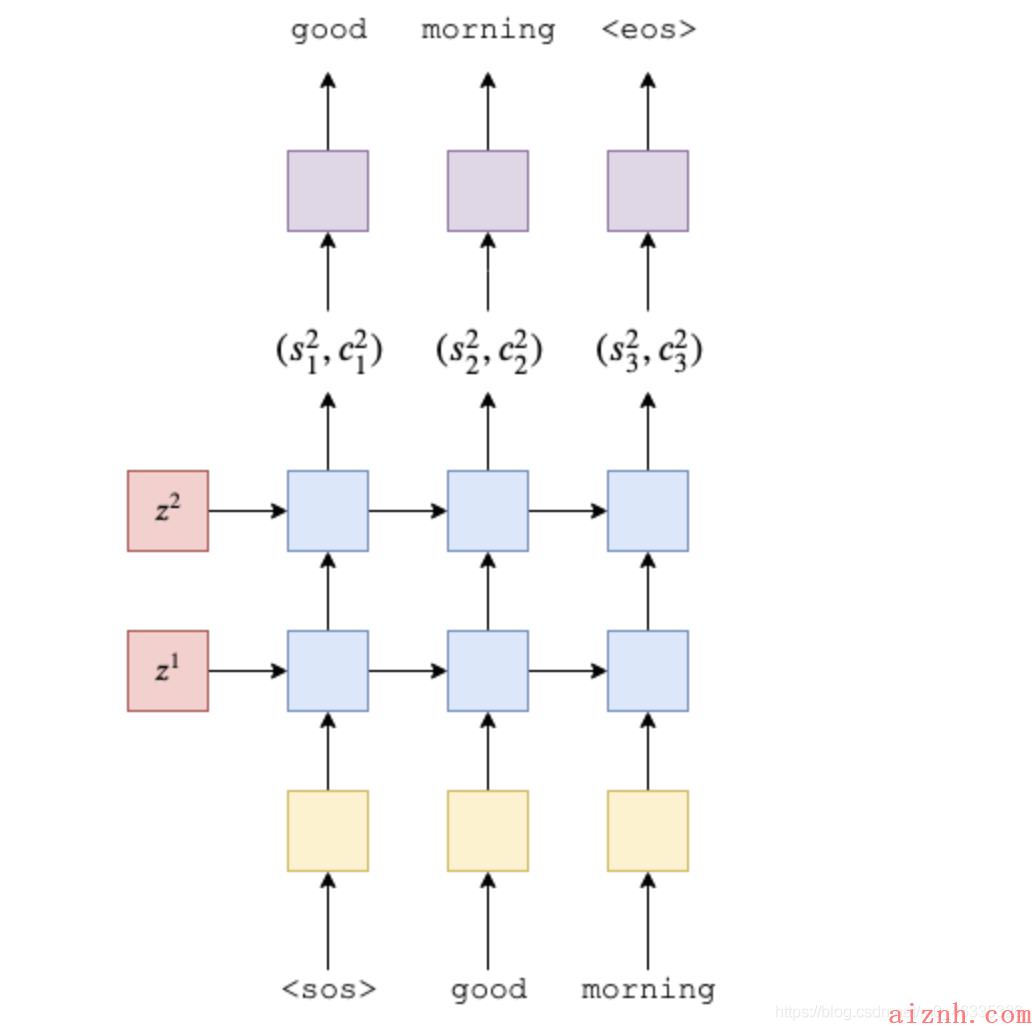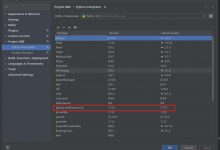1 介绍
在本系列中,我们将使用PyTorch和TorchText构建一个机器学习模型,从一个序列到另一个序列。 这将在德语到英语的翻译中完成,但是模型可以应用于涉及从一个序列到另一个序列的任何问题。(本篇论文“Sequence to Sequence Learning with Neural Networks ”)
最常见的序列到序列(seq2seq)模型是编码器-解码器模型,通常使用递归神经网络(RNN)将源(输入)语句编码为单个向量。 在本笔记中,我们将将此单个向量称为上下文向量。 我们可以将上下文向量视为整个输入句子的抽象表示。 然后,该向量由第二个RNN解码,该第二个RNN通过一次生成一个单词来学习输出目标(输出)语句。
上图显示了示例翻译。 输入/源句子“ guten morgen”穿过嵌入层(黄色),然后输入到编码器中(绿色)。 我们还将序列的开头()和序列的结尾()标记分别附加到句子的开头和结尾。 在每个时间步,编码器RNN的输入既是当前单词e(x_t)的嵌入,也是前一个时间步的隐藏状态 h (t -1) ,编码器RNN输出新的隐藏状态h_t 。 到目前为止,我们可以将隐藏状态视为句子的向量表示。 RNN可以表示为 e(x_t)和 h_ {t-1} 的函数:
将隐藏层最后一个输出h_t当作源句子的向量z
添加句子的起始和结束单词,隐藏层输入为S(t-1),起始的S_0为句子向量即s_0 = z = h_t(the initial decoder hidden state is the final encoder hidden state):
在句子中至少出现两次的单词才允许在词汇表中出现,只出现一次的单词使用
<unk>
代替
2 模型构建
模型分为三个部分:编码器,译码器以及seq2seq整合模型
- Encoder:
1)两层LSTM


在这些教程中,我们不会详细讨论嵌入层。 我们所需要知道的是,在将单词(从技术上讲,单词的索引)传递到RNN之前,需要一步,然后将RNN转换为向量。
【注】 - 输入的词向量(input_dim)维度与one-hot相同(也与词汇表大小相同,实质是利用索引)
- hid_dim为隐藏层单元数
我们传入源语句X,该语句使用嵌入层转换为密集向量,然后应用dropout。 然后将这些嵌入传递到RNN。 当我们将整个序列传递给RNN时,它将为我们自动对整个序列进行隐藏状态的递归计算! 注意,我们没有将初始的隐藏状态或单元状态传递给RNN。 这是因为,如文档中所述,如果没有将任何隐藏/单元状态传递给RNN,它将自动创建初始隐藏/单元状态作为全零的张量。
class Encoder(nn.Module):def __init__(self, input_dim, emb_dim, hid_dim, n_layers, dropout):super().__init__()self.hid_dim = hid_dimself.n_layers = n_layers#RNN的层数self.embedding = nn.Embedding(input_dim, emb_dim)self.rnn = nn.LSTM(emb_dim, hid_dim, n_layers, dropout = dropout)self.dropout = nn.Dropout(dropout)def forward(self, src):#src = [src len, batch size]#实质上使用的词向量的索引embedded = self.dropout(self.embedding(src))#embedded = [src len, batch size, emb dim]outputs, (hidden, cell) = self.rnn(embedded)#outputs = [src len, batch size, hid dim * n directions]#hidden = [n layers * n directions, batch size, hid dim]#cell = [n layers * n directions, batch size, hid dim]#outputs are always from the top hidden layerreturn hidden, cell
- Decoder


解码器的初始隐藏状态和单元状态是上下文向量,它们是同一层编码器的最终隐藏状态和单元状态
参数和初始化与Encoder类类似,output_dim是输出/目标的词汇大小,还添加了线性层,用于根据顶层隐藏状态进行预测。
在forward方法中输入一个batch词向量,先前的隐藏状态和先前的单元状态。由于我们一次只解码一个单词,因此输入单词的序列长度始终为1。我们对输入单词进行解压以添加句子长度维度1。然后,类似于编码器,我们穿过一个嵌入层并申请辍学。然后将这批嵌入式令牌与先前的隐藏状态和单元状态一起传递到RNN中。这将产生一个输出(RNN顶层的隐藏状态),一个新的隐藏状态(每一层一个,彼此堆叠)和一个新的单元状态(每层一个状态,一个彼此堆叠)。然后,我们将输出(除去句子长度维度后)通过线性层以接收我们的预测。然后,我们返回预测,新的隐藏状态和新的单元状态。
注意:由于我们的序列长度始终为1,因此可以使用nn.LSTMCell而不是nn.LSTM,因为它被设计为处理一批不一定在序列中的输入。 nn.LSTMCell只是一个单元格,而nn.LSTM是可能多个单元格的包装。在这种情况下使用nn.LSTMCell意味着我们不必放松即可添加假序列长度尺寸,但是在解码器中,每层我们需要一个nn.LSTMCell并确保每个nn.LSTMCell都接收正确的初始隐藏编码器的状态。所有这些使代码不太简洁-因此决定坚持常规nn.LSTM。
class Decoder(nn.Module):def __init__(self, output_dim, emb_dim, hid_dim, n_layers, dropout):super().__init__()self.output_dim = output_dimself.hid_dim = hid_dimself.n_layers = n_layersself.embedding = nn.Embedding(output_dim, emb_dim)self.rnn = nn.LSTM(emb_dim, hid_dim, n_layers, dropout = dropout)self.fc_out = nn.Linear(hid_dim, output_dim)self.dropout = nn.Dropout(dropout)def forward(self, input, hidden, cell):#input = [batch size]#hidden = [n layers * n directions, batch size, hid dim]#cell = [n layers * n directions, batch size, hid dim]#n directions in the decoder will both always be 1, therefore:#hidden = [n layers, batch size, hid dim]#context = [n layers, batch size, hid dim]input = input.unsqueeze(0)#input = [1, batch size]embedded = self.dropout(self.embedding(input))#embedded = [1, batch size, emb dim]output, (hidden, cell) = self.rnn(embedded, (hidden, cell))#output = [seq len, batch size, hid dim * n directions]#hidden = [n layers * n directions, batch size, hid dim]#cell = [n layers * n directions, batch size, hid dim]#seq len and n directions will always be 1 in the decoder, therefore:#output = [1, batch size, hid dim]#hidden = [n layers, batch size, hid dim]#cell = [n layers, batch size, hid dim]prediction = self.fc_out(output.squeeze(0))#prediction = [batch size, output dim]return prediction, hidden, cell
- Seq2Seq
1)接收输入/源句
2)使用编码器产生上下文向量
3)使用解码器产生预测的输出/目标句子
对于此实现,我们必须确保编码器和解码器中的层数和隐藏(和单元)尺寸相等。并非总是如此,在序列到序列模型中,我们不一定需要相同数量的层或相同的隐藏尺寸大小。但是,如果我们做了一些类似的事情,例如拥有不同数量的层,那么我们将需要决定如何处理。例如,如果我们的编码器有2层,而我们的解码器只有1层,该如何处理?我们是否平均解码器输出的两个上下文向量?我们是否都穿过线性层?我们是否仅使用最高层的上下文向量?我们将使用模型预测的令牌作为模型的下一个输入,即使它与序列中实际的下一个令牌不匹配也是如此。
在decoder每一次loop中做以下工作:
1)输入前一个时间点(y_t, s_{t-1}, c_{t-1})
2)得到当前时间点的 (y_{t+1}, s_t, c_t)
3)将y_{t+1}放入张量y’中
4)是否采用 “teacher force”
经过loop最后返回y’
class Seq2Seq(nn.Module):def __init__(self, encoder, decoder, device):super().__init__()self.encoder = encoderself.decoder = decoderself.device = deviceassert encoder.hid_dim == decoder.hid_dim, \\\"Hidden dimensions of encoder and decoder must be equal!\"assert encoder.n_layers == decoder.n_layers, \\\"Encoder and decoder must have equal number of layers!\"def forward(self, src, trg, teacher_forcing_ratio = 0.5):# teacher_forcing_ratio使用正确的下一个单词去训练(不知道理解的对错)#src = [src len, batch size]#trg = [trg len, batch size]#teacher_forcing_ratio is probability to use teacher forcing#e.g. if teacher_forcing_ratio is 0.75 we use ground-truth inputs 75% of the timebatch_size = trg.shape[1]trg_len = trg.shape[0]trg_vocab_size = self.decoder.output_dim#需要定义一个张量,存储所有预测出的结果y‘#tensor to store decoder outputsoutputs = torch.zeros(trg_len, batch_size, trg_vocab_size).to(self.device)#last hidden state of the encoder is used as the initial hidden state of the decoderhidden, cell = self.encoder(src)#first input to the decoder is the <sos> tokensinput = trg[0,:]for t in range(1, trg_len):#insert input token embedding, previous hidden and previous cell states#receive output tensor (predictions) and new hidden and cell statesoutput, hidden, cell = self.decoder(input, hidden, cell)#place predictions in a tensor holding predictions for each tokenoutputs[t] = output#decide if we are going to use teacher forcing or notteacher_force = random.random() < teacher_forcing_ratio#get the highest predicted token from our predictionstop1 = output.argmax(1)#if teacher forcing, use actual next token as next input#if not, use predicted tokeninput = trg[t] if teacher_force else top1return outputs
3 训练模型
- 输入和输出向量的维度由词汇表大小决定,词向量维度和正则化使用可以改变,hidden cell和layers需要保持统一。
INPUT_DIM = len(SRC.vocab)OUTPUT_DIM = len(TRG.vocab)ENC_EMB_DIM = 256DEC_EMB_DIM = 256HID_DIM = 512N_LAYERS = 2ENC_DROPOUT = 0.5DEC_DROPOUT = 0.5enc = Encoder(INPUT_DIM, ENC_EMB_DIM, HID_DIM, N_LAYERS, ENC_DROPOUT)dec = Decoder(OUTPUT_DIM, DEC_EMB_DIM, HID_DIM, N_LAYERS, DEC_DROPOUT)model = Seq2Seq(enc, dec, device).to(device)def init_weights(m):for name, param in m.named_parameters():nn.init.uniform_(param.data, -0.08, 0.08)model.apply(init_weights)
训练
def train(model, iterator, optimizer, criterion, clip):model.train()epoch_loss = 0for i, batch in enumerate(iterator):src = batch.srctrg = batch.trgoptimizer.zero_grad()output = model(src, trg)#trg = [trg len, batch size]#output = [trg len, batch size, output dim]output_dim = output.shape[-1]output = output[1:].view(-1, output_dim)trg = trg[1:].view(-1)#trg = [(trg len - 1) * batch size]#output = [(trg len - 1) * batch size, output dim]loss = criterion(output, trg)loss.backward()torch.nn.utils.clip_grad_norm_(model.parameters(), clip)optimizer.step()epoch_loss += loss.item()return epoch_loss / len(iterator)
在评估模型时,我们使用with torch.no_grad()块来确保在该块内不计算梯度,这样可以减少内存消耗并加快处理速度。
def evaluate(model, iterator, criterion):model.eval()epoch_loss = 0with torch.no_grad():for i, batch in enumerate(iterator):src = batch.srctrg = batch.trgoutput = model(src, trg, 0) #turn off teacher forcing#trg = [trg len, batch size]#output = [trg len, batch size, output dim]output_dim = output.shape[-1]output = output[1:].view(-1, output_dim)trg = trg[1:].view(-1)#trg = [(trg len - 1) * batch size]#output = [(trg len - 1) * batch size, output dim]loss = criterion(output, trg)epoch_loss += loss.item()return epoch_loss / len(iterator)
我们终于可以开始训练我们的模型了!
在每个时期,我们都会检查模型是否达到了迄今为止的最佳验证损失。 如果有,将更新最好的验证损失并保存模型的参数(在PyTorch中称为state_dict)。 当我们测试模型时,将使用保存的参数来获得最佳的验证损失。
N_EPOCHS = 10CLIP = 1best_valid_loss = float(\'inf\')for epoch in range(N_EPOCHS):start_time = time.time()train_loss = train(model, train_iterator, optimizer, criterion, CLIP)valid_loss = evaluate(model, valid_iterator, criterion)end_time = time.time()epoch_mins, epoch_secs = epoch_time(start_time, end_time)if valid_loss < best_valid_loss:best_valid_loss = valid_losstorch.save(model.state_dict(), \'tut1-model.pt\')print(f\'Epoch: {epoch+1:02} | Time: {epoch_mins}m {epoch_secs}s\')print(f\'\\tTrain Loss: {train_loss:.3f} | Train PPL: {math.exp(train_loss):7.3f}\')print(f\'\\t Val. Loss: {valid_loss:.3f} | Val. PPL: {math.exp(valid_loss):7.3f}\')
 爱站程序员基地
爱站程序员基地








